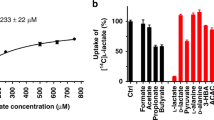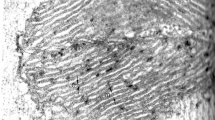Summary
The substrate and inhibitor specificity of the lactic acid (Lac) transport system of human neutrophils was investigated. The ability of a variety of compounds to inhibit the influx of [14C]lactate, presumably reflecting competition by substrate analogues for binding at the external translocation site, was taken as an index of affinity for the Lac carrier. pH-stat techniques were utilized to assess transportability. Results indicate a relatively low order of selectivity, the neutrophil H+ + lactate− cotransport system demonstrating a broad acceptance of short-chain unsubstituted and substituted alkyl monocarboxylates as well as aromatic monocarboxylates. There was a slight preference for oxo, Cl, and OH substituents over other groups at the two-position of short chain alkyl fatty acids: all were readily transported across the plasma membrane at rates approaching that ofl-lactate itself. Aromatic acids were not transported inward by the carrier although these compounds did permeate via simple nonionic diffusion. The neutrophil Lac carrier can be blocked by a number of cyanocinnamate derivatives, the classical inhibitors of monocarboxylate transport in mitochondria, and by dithiol compounds and sulfhydryl-reactive agents. This constellation of biochemical properties is similar to the features that characterize other well described H+ + lactate− cotransport systems in red blood cells, Ehrlich ascites tumor cells, hepatocytes, and cardiac sarcolemmal vesicles, although significant differences exist when comparisons are made to the Na+-dependent lactate transporter of the kidney proximal tubule.
Similar content being viewed by others
References
Andersen, B.L., Tarpley, H.L., Regen, D.M. 1978. Characterization ofβ-hydroxybutyrate transport in rat erythrocytes and thymocytes.Biochim. Biophys. Acta 508:525–538
Barac-Nieto, M., Murer, H., Kinne, R. 1982. Asymmetry in the transport of lactate by basolateral and brush border membranes of rat kidney cortex.Pfluegers Arch. 392: 366–371
Boumendil-Podevin, E.F., Podevin, R.A. 1981. Nicotinic acid transport by brush border membrane vesicles from rabbit kidney.Am. J. Physiol. 240:17185–17191
Boyum, A. 1968. Isolation of mononuclear cells and granulocytes from human blood.Scand. J. Clin. Lab. Invest. 21(suppl. 97):77–89
Deuticke, B. 1977. Properties and structural basis of simple diffusion pathways in the erythrocyte membrane.Rev. Physiol. Biochem. Pharmacol. 78:1–97
Deuticke, B., Rickert, I., Beyer, E. 1978. Stereoselective, SH-dependent transfer of lactate in mammalian erythrocytes.Biochim. Biophys. Acta 507:137–155
Deuticke, B. 1979. The specific monocarboxylate carrier system in the erythrocyte membrane.In: Biophysics of Membrane Transport. Fifth Winter School on Biophysics of Membrane Transport. J. Kuczera, J. Gabrielska, and S. Przestalski, editors. pp. 158–190. University of Wroczlaw, Poland
Deuticke, B. 1982. Monocarboxylate transport in erythrocytes.J. Membrane Biol. 70:89–103.
Deuticke, B. 1989. Monocarboxylate transport in red blood cells: kinetics and chemical modification.Methods Enzymol. 173:300–329.
Deuticke, B., Beyer, E., Forst, B. 1982. Discrimination of the three parallel pathways of lactate transport in human erythrocyte membrane by inhibitors and kinetic properties.Biochim. Biophys. Acta 684:96–110
Dubinsky, W.P., Racker, E. 1978. The mechanism of lactate transport in human erythrocytes. J. Membrane Biol.44:25–36
Edlund, G.L., Halestrap, A.P. 1988. The kinetics of transport of lactate and pyruvate into rat hepatocytes: evidence for the presence of a specific carrier similar to that in erythrocytes.Biochem. J. 249:117–126
Fafournoux, P.C., Demigne, C., Remesey, C. 1985. Carrier mediated uptake of lactate in rat hepatocytes.J. Biol. Chem. 260:292–299
Grinstein, S., Furuya, W. 1986. Characterization of the amiloride-sensitive Na+-H+ antiport of human neutrophils.Am. J. Physiol. 250:C283-C291
Halestrap, A.P. 1975. The mitochondrial pyruvate carrier. Kinetics and specificity for substrates and inhibitors.Biochem. J. 148:85–96
Halestrap, A.P. 1976. Transport of pyruvate and lactate into human erythrocytes. Evidence for the involvement of the chloride carrier and a chloride-independent carrier.Biochem. J. 156:193–207
Halestrap, A.P., Denton, R.M. 1974. Specific inhibition of pyruvate transport in rat liver mitochondria and human erythrocytes by a-cyano-4-hydroxycinnamate.Biochem. J. 138:313–316
Halestrap, A.P., Denton, R.M. 1975. The specificity and metabolic implications of the inhibition of pyruvate transport in isolated mitochondria and intact tissue preparations byα-cyano-4-hydroxycinnamate and related compounds.Biochem. J. 148:97–106
Hildmann, B., Storelli, C., Haase, W., Barac-Nieto, M., Murer, H. 1980. Sodium ion/L-lactate cotransport in rabbit small intestinal brush-border membrane vesicles.Biochem. J. 186:169–176
Kaplan, R.S., Mayor, J.A., Johnston, N., Oliveira, D.L. 1990. Purification and characterization of the reconstitutively active tricarboxylate transporter from rat liver mitochondria.J. Biol. Chem. 265:13379–13385
Koch, A., Webster, B., Lowell, S. 1981. Cellular uptake of L-lactate in mouse diaphragm.Biophys. J. 36:775–796
Nord, E.P., Wright, S.H., Kippen, I., Wright, E.M. 1983. Specificity of the Na+-dependent monocarboxylic acid transport pathway in rabbit renal brush border membranes.J. Membrane Biol. 72:213–221
Poole, R.C., Cranmer, S.L., Halestrap, A.P., Levi, A.J. 1990. Substrate and inhibitor specificity of monocarboxylate transport into heart cells and erythrocytes: further evidence for the existence of two distinct carriers.Biochem. J. 269:827–829
Poole, R.C., Halestrap, A.P., Price, S.J., Levi, A.J. 1989. The kinetics of transport of lactate and pyruvate into isolated cardiac myocytes from guinea pig: kinetic evidence for the presence of a carrier distinct from that in erythrocytes and hepatocytes.Biochem. J. 264:409–418
Restrepo, D., Kozody, D.J., Spinelli, L.J., Knauf, P.A. 1989. pH homeostasis in promyelocytic leukemic HL60 cells.J. Gen. Physiol. 92:489–507
Siebens, A.W., Boron, W.F. 1987. Effect of electroneutral luminal and basolateral lactate transport on intracellular pH in salamander proximal tubules.J. Gen. Physiol. 90:799–831
Simchowitz, L. 1988. Properties of the principal anion exchange mechanism in human neutrophils. In: Cell Physiology of Blood. R.B. Gunn and J.C. Parker, editors. Society of General Physiologists Series, volume 43. pp. 193–208. Rockefeller University, New York
Simchowitz, L., De Weer, P. 1986. Chloride movements in human neutrophils: exchange, diffusion, and active transport.J. Gen. Physiol. 88:167–194
Simchowitz, L., Ratzlaff, R., De Weer, P. 1986. Anion/anion exchange in human neutrophils.J. Gen. Physiol. 88:195–217
Simchowitz, L., Roos, A. 1985. Regulation of intracellular pH in human neutrophils.J. Gen. Physiol. 85:443–470
Simchowitz, L., Spilberg, I., De Weer, P. 1982. Sodium and potassium fluxes and membrane potential of human neutrophils. Evidence for an electrogenic sodium pump.J. Gen. Physiol. 79:453–479
Simchowitz, L., Textor, J.A. 1992. Lactic acid secretion by human neutrophils: evidence for an H+ + lactate− cotransport system.J. Gen. Physiol. 100:341–367
Simchowitz, L., Textor, J.A., Vogt, S.K. 1991. Use of tributyltin to probe contribution of C−-HCO −3 exchange to regulation of steady-state pHi in human neutrophils.Am. J. Physiol. 261:C906-C915
Spencer, T.L., Lehninger, A.L. 1976. L-Lactate transport in Ehrlich ascites-tumour cells.Biochem. J. 154:405–414
Trosper, T.L., Philipson, K.D. 1987. Lactate transport by cardiac sarcolemmal vesicles.Am. J. Physiol. 252: C483-C489
Trosper, T.L., Philipson, K.D. 1989. Functional characteristics of the cardiac sarcolemmal monocarboxylate transporter.J. Membrane Biol. 112:15–23
Ullrich, K.J., Rumrich, G., Kloss, S. 1982. Reabsorption of monocarboxylic acids in the proximal tubule of the rat kidney. I. Transport kinetics of D-lactate, Na+-dependence, pH dependence and effect of inhibitors.Pfluegers Arch. 395:212–219
Ullrich, K.J., Rumrich, G., and Kloss, S. 1982. Reabsorption of monocarboxylic acids in the proximal tubule of the rat kidney. II. Specificity for aliphatic compounds.Pfluegers Arch. 395:220–226
Ullrich, K.J., Rumrich, G., Kloss, S., Fasold, H. 1982. Reabsorption, of monocarboxylic acids in the proximal tubule of the rat kidney. III. Specificity for aromatic compounds.Pfluegers Arch. 395:227–231
Wright, E.M. 1985. Transport of carboxylic acids by renal membrane vesicles.Anna. Rev. Physiol. 47:127–141
Author information
Authors and Affiliations
Rights and permissions
About this article
Cite this article
Simchowitz, L., Vogt, S.K. Substrate and inhibitor specificity of the lactate carrier of human neutrophils. J. Membrain Biol. 131, 23–34 (1993). https://doi.org/10.1007/BF02258531
Received:
Revised:
Issue Date:
DOI: https://doi.org/10.1007/BF02258531




